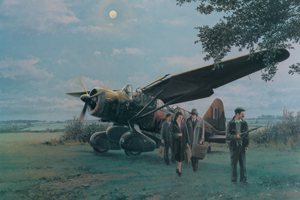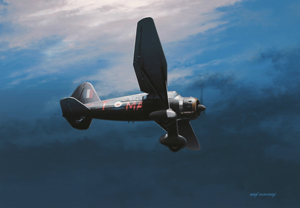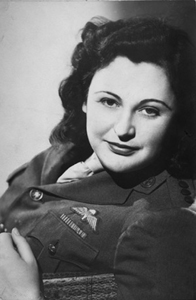Within weeks of the fall of France in 1940, the British began preparations to send secret agents into Nazi-occupied Europe. In July, Prime Minister Winston Churchill set up the Special Operations Executive with a charter that included sabotage, espionage, assistance to Resistance movements, and other clandestine activities.
 | ||
|
“They Landed by Moonlight,” painted by Robert Taylor, depicts a typical rendezvous between secret agents and a member of the French Resistance deep in Nazi-occupied France. (“They Landed by Moonlight” painting by Robert Taylor © The Military Gallery, Ojai, Calif.) |
SOE was not part of the regular Secret Intelligence Service. It was a separate agency with its own minister. Its exploits are legendary today, but it was a tightly held secret during World War II. Its existence was not revealed to the public until the war was over.
On behalf of SOE, Foreign Office officials approached the Air Ministry in the summer of 1940 to ask if agents could be parachuted or flown into France and the Low Countries. They got a frosty reception. Air Vice Marshal (later Air Chief Marshal) Arthur Harris did not want to divert airplanes and pilots, needed elsewhere, “to carry ragamuffins to distant spots.”
Others—notably Churchill—disagreed and SOE got its support. Over the next five years, RAF would drop, deliver, or pick up thousands of SOE agents in continental Europe.
For that purpose, two special duty squadrons were formed at RAF Tempsford, north of London. At first, both of them flew single-engine Westland Lysanders, but shortly thereafter, No. 138 Squadron switched to modified Halifax bombers and specialized in airdrops of agents and equipment.
No. 161 Squadron took over all of the Lysanders. On nights when the moon was full, they landed behind enemy lines without lights on grass fields and improvised airstrips as short as 150 yards. As agents arriving from England climbed down the fixed ladder from the rear cockpit, passengers waiting to be picked up ran onto the field, scrambled aboard, and minutes later were on their way. Both squadrons depended on moonlight for visibility over the landing zones and drop zones.
The operation got off to an awkward start the night of Oct. 19, 1940. SOE agent Philip Schneidau, having completed his assignment in France, was ready for pickup. The weather was bad, but Flight Lt. W. R. Farley took off hoping it would improve. The sliding roof was removed from the rear cockpit to make it easier for Schneidau to board, but the radio in back was inoperable after being soaked by rain.
Farley picked up Schneidau and took off. As he struggled to free a sticking elevator, he passed low over a nearby village where a lucky shot by a sentry hit the cockpit of the Lysander and destroyed the compass.
The weather en route had not abated, and Farley searched with increasing urgency for a gap in the clouds and an emergency landing field. He finally set down at Oban in western Scotland with his fuel gauge on empty. Unable to reveal the nature of the mission to the suspicious RAF station commander, Farley and Schneidau were held under guard until vouched for by higher headquarters.
The Lysander
The Lysander was not the only kind of airplane No. 161 Squadron had, but it accounted for most of the insertions and extractions in France. It was light (just over two tons) and rugged, with a long 50-foot wingspan. It entered service in 1938 as an “army cooperation” airplane used for spotting and reconnaissance, but found its natural home with the Moon Squadrons.
Some accounts say the Lysander needed an airstrip of 500 yards or longer, but the Tempsford pilots could and usually did land in 150 yards from touchdown to turnaround, according to Group Capt. Hugh Verity, who made 30 such landings as a squadron leader during the war.
The three-bladed propeller was driven by big Bristol Mercury radial engine, generating a top speed of 230 mph. More significantly, it could fly as slow as 55 mph without stalling.

| ||
|
A Lysander flies under the clouds on a Moon Squadron mission in this painting by Ivan Berryman. (Courtesy of Ivan Berryman) |
“The wings were equipped with automatic slats which lifted away from the leading edge as the speed decreased toward stalling speed,” Verity said. “These slats controlled automatic flaps. Slow speed flight was therefore greatly simplified and it was possible to bring a Lysander down to land, if not like a lift, at least like an escalator.”
Rough landing fields were seldom a problem for the strong undercarriage formed by an alloy beam in the shape of an inverted V. The fixed landing gear had streamlined fairings, called “spats,” over the wheels to reduce turbulence. The high wings, which gave the pilot a good view downward on both sides, were braced with sturdy struts.
Every pound of nonessential equipment was stripped out to give the Lysander as much range as possible. With an auxiliary fuel tank underneath the fuselage, it could cover a round trip of 1,150 miles.
It was rated for two passengers but often carried three and, in several documented instances, squeezed in four. A fixed ladder helped passengers deplane and board quickly. The top rungs were painted yellow to make them easier to see.
“The whole aeroplane had been painted matte black all over, in the mistaken belief that this would help make it invisible at night,” Verity said. “While this may have been true for searchlights, the night flyer’s view from above on a moonlit night was a very different matter. We found that the silhouette against low cloud was far too positive. So I had the upper surfaces recamouflaged in dark green and pale gray.”
When circumstances permitted, No. 161 Squadron used two-engine Lockheed Hudsons for pickups of larger parties. The Hudson carried a navigator and a radio operator-gunner and could accommodate eight to 10 passengers. It supposedly required a 1,000-yard airstrip to land but Moon Squadron pilots made do with 350 yards from touchdown to turnaround.
The Hudsons had enough range to fly their missions directly from Tempsford, but the Lysanders used a forward staging base at RAF Tangmere on the southern coast of England.
The Moon Squadron pilots called all of the SOE agents “Joes,” men and women alike. “When we parachuted agents into the field we never—or only rarely—knew who they were,” said Air Chief Marshal Lewis Hodges, who flew both pickup and airdrop missions as a squadron leader at Tempsford. “We perhaps knew their code names but that was all.” The agents “were brought to Tempsford at the last moment from a special holding unit, a country house in the vicinity, and they were brought onto the airfield with as much secrecy as possible.”
That may have been the case for the multi-engine crews, but the Joes had considerable contact with the Lysander pilots, who trained them to assist in the moonlight landings. “We became very friendly with individual agents,” Verity said.
In November 1943, Hodges flew a Hudson into France to pick up a party that included an agent called “Morland.” As he learned later, Morland was François Mitterand, a future President of France. From Tempsford, Morland was taken to London to confer with Charles de Gaulle, leader of the Free French forces, and flown back into France in February 1944.
The White Mouse

| ||
|
The Lysanders flew most of the Moon Squadron landing missions. The Lockheed Hudson was used to pick up larger groups of passengers when circumstances permitted. Airdrops of agents and materiel were conducted by larger aircraft, chiefly the four-engine Halifax. (Source: Group Capt. Hugh Verity) |
About 50 of the SOE agents in France were women. The most famous of them was Violette Szabo, who was of French-English descent and spoke fluent French. Her husband, a French Foreign Legion captain, had been killed by the Germans. She was flown into and out of France by a Moon Squadron Lysander in April 1944, then parachuted back in for her next mission. On June 10, Szabo was captured after a gun battle at a roadblock in which she killed at least one German. Interrogated and executed at Ravensbrück concentration camp, she was awarded the George Cross, the highest civil decoration of the United Kingdom, posthumously.
Almost as well known was Nancy Wake, called “the White Mouse” by the Gestapo, which placed a large bounty on her head. She evaded capture, helped downed fliers to escape, led guerilla fighters in armed operations, and sentenced a traitor to death by firing squad. Wake, always stylish, traveled nowhere without her Chanel lipstick and said she had not parachuted into France “to fry eggs and bacon for the men.” She survived the war and at age 96 attended the gathering of SOE and Moon Squadron veterans and families at Tangmere in 2006.
SOE’s rival in clandestine operations, the Secret Intelligence Service, also sent agents into France via the Moon Squadrons. SIS and SOE used the same aircraft, but never together. American aircraft flew some of the airdrop missions as well.
Landing by Moonlight
The forward base at Tangmere was almost 100 miles south of Tempsford, which enabled the Lysanders to fly deeper into France. “We were normally there for about a week before and a week after each full moon,” Verity said. “We walked across to the normal RAF officers’ mess for meals at the usual times when we had no secret visitors. Our ground crew were lodged in the main station.”
The pilots were billeted at Tangmere Cottage, opposite the main gates of the RAF station and partially hidden by tall hedges. The cottage had a kitchen and two living rooms, an operations room, and a dining room on the ground floor and five or six bedrooms upstairs. Two flight sergeants, Steve Blaber and Bill Booker of the RAF service police, handled everything from cooking to security at the cottage. They served breakfast at any time of night.
The BBC broadcast coded messages to let agents and Resistance leaders know when their missions were on. A January 1943 message, “Le castor foulera la neige deux fois” (“The beaver will tread the snow twice”), for example, was notification that two Lysanders rather than one would be coming for a delivery and pickup that night.
Navigation was necessarily by dead reckoning. The Lysander pilots flew a course plotted in detail ahead of time and estimated their position from the compass heading, time flown, and airspeed. They also watched for recognizable features on the ground.

| ||
|
Nancy Wake, aka “The White Mouse,” survived her daring exploits as a secret agent. |
“Water was the best landmark,” Verity said. “Coast, rivers, or lakes, and after that, forests and railways.” The Loire river was frequently a landmark, as was the town of Blois, just beyond.
The pilots made their own cockpit maps from larger “half-million” (scale of one-to-500,000) maps. From these, they cut a long strip with their route in the middle and covering 50 miles to either side. The strip map was then folded so the pilot could hold it in one hand and study two panels while flying. The last two panels used a closer scale (one-to-250,000) for more detail on final approach to the landing site.
Before the Joes left Tempsford, they were taught by the Lysander pilots how to stake out a flarepath with pocket flashlights or bicycle lamps to mark a landing site in the moonlight. The flarepath was in the shape of an inverted L, about 150 yards long. As the Lysander approached, the agent flashed an agreed-upon letter in Morse code. When the pilot acknowledged the signal, the other lights were switched on.
“After the Lysander had landed and turned around ready to take off into the wind, the load had to be changed over in under three minutes,” Verity said.
One night in April 1942 at Pont-de-Vaux, France, the agent in charge of the landing was drunk and laid the flarepath over a ditch. The landing broke the undercarriage, so Squadron Leader Guy Lockhart burned the airplane and made his way overland with the passengers to British-held Gibraltar.
Hazardous Work
The landings would have been even more dangerous if the German air defenses had not been preoccupied with nightly attacks by Allied bombers. Even so, between 1940 and 1944, the Moon Squadrons lost 13 Lysanders on 279 sorties flown. Six pilots were killed on pickup operations. In addition to the losses, there were numerous close calls.
On Dec. 8, 1941, Flight Lt. A. M. Murphy approached Neufchâteau, Belgium, for a scheduled pickup. The Morse signal flashed from the ground was the wrong letter, but Murphy decided to land anyway. The Germans were waiting and opened up on Murphy, who took off under fire.
The agent, unable to warn Murphy, watched from a distance as Murphy was hit by the ground fire. The agent had been surprised by the Germans when setting up the flarepath and was lucky to have gotten away. Murphy, lightheaded from loss of blood, landed at Tangmere with 30 bullet holes in his Lysander.
The enemy was not the only hazard. In April 1943, Flight Lt. John Bridger shredded a tire in a bad landing. Figuring the Lysander would be too difficult to control with only one good tire, he shot out the other one with his Smith & Wesson .38 service revolver. It took five shots to flatten it, but the rims rolled easily over the dry, hard ground and Bridger took off without incident.
Improvised solutions were more difficult when No. 161 Squadron’s Hudsons, larger and heavier than the Lysanders, ran into trouble on landings. On Feb. 8, 1944, Flight Officer John Affleck set down near Bletterans in eastern France to pick up a senior Resistance leader and his family. The field had been frozen but was thawed when Affleck landed at 11:30 p.m.
The ground team and the passengers pushed the airplane to the takeoff point and turned it around, but the wheels promptly sank into the mud. Villagers with oxen and horses came to assist. Activity paused while a German airplane flew past overhead.
Affleck decided that if he could not get away by 3 a.m., he would destroy the airplane and make a run for the Spanish border. The workers dug two channels for the wheels and Affleck taxied forward with a minimum load and got the Hudson into the air. He arrived in England at 6:40 a.m., with both humans and airplane covered in mud.

| ||
|
Violette Szabo was awarded the George Cross posthumously for her work as a “Joe.” |
No. 138 Squadron had the less glamorous side of the operation, flying more than 2,500 sorties to drop 40,000 packages and 995 Joes into occupied Europe. Nearly all of these missions were in Handley Page Halifax bombers, modified to provide a parachute hatch called the “Joe hole.”
“We sometimes dropped agents in the dark period with no moon, and these were often what we call blind drops. There was no reception committee on the ground and this method had security advantages, but there was always the risk of injury in the parachute landings,” said Hodges.
One of the Halifax missions remains clouded in mystery. The aircraft, flown by Wing Commander W. R. Farley—the same officer who flew the very first Moon Squadron mission back in 1940—crashed into a mountain in Bavaria on April 20, 1942. Not much is known about the flight. It was part of secret Operation Pickaxe, in which the RAF dropped more than 20 Soviet agents into Western Europe by parachute.
The Front Moves Forward
The peak year of activity was 1943, when the Moon Squadrons made 125 landings in France. The front moved forward after D-Day in 1944 as French territory was steadily liberated. Allied special forces “Jedburgh” teams parachuted in ahead of the invasion forces to reinforce the SOE agents and the irregulars. The requirement diminished for Lysander pickups and the aircraft were reassigned to nonoperational transport duties.
After the war, SOE was dissolved. Some of its assets were transferred to the Special Operations Branch of the Secret Intelligence Service, MI6.
No. 138 Squadron was assigned to other duties elsewhere and No. 161 Squadron was disbanded in June 1945.
Some of the heritage of the Moon Squadrons is preserved by the Tangmere Military Aviation Museum, established in 1982 on the site of the old airfield. Tangmere Cottage still stands, registered as a building of special historic interest.
The Lysanders were withdrawn from RAF service in 1946.
Among the Lysanders on exhibit in various museums today is one at the Udvar Hazy annex of the National Air and Space Museum in Chantilly, Va.
It is displayed with the paint scheme and markings of No. 138 Squadron at Tempsford in 1941.